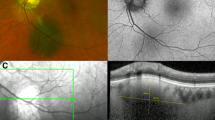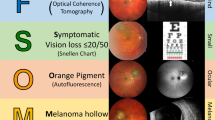Abstract
Introduction
The MOLES score has been validated to clinically differentiate choroidal naevi from melanomas by ocular oncologists and community optometrists. However, its utility in a virtual choroidal naevi clinic at a tertiary eye hospital without specialist ocular oncology services has not yet been evaluated.
Methods
A retrospective case review of 385 choroidal lesions in the virtual choroidal naevus clinic at Bristol Eye Hospital during January–March 2020 and April–August 2021 was performed. Choroidal lesions were assessed using the TFSOM-UHHD risk factor index and MOLES score, respectively. For both study periods, clinical outcome and adherence data were analysed.
Results
Choroidal lesions scored higher with the TFSOM-UHHD index (median 2) compared to the MOLES score (median 0; p < 0.001). Median required follow-up duration was 2 years for lesions assessed with the TFSOM-UHHD index, and 0 years for those graded with the MOLES score. Overall, 215 patients were appropriately discharged to community optometrists based on their MOLES score. Imaging requirements for the TFSOM-UHHD index and MOLES score protocols were met in 69.1% and 94.8% of cases, respectively.
Conclusion
The MOLES score was easily implemented in a virtual choroidal naevus clinic, with good adherence. It increased clinic capacity by facilitating appropriate discharges of low-risk naevi to community monitoring, allowing finite and specialist hospital-based services to monitor higher-risk naevi more closely.
This is a preview of subscription content, access via your institution
Access options
Subscribe to this journal
Receive 18 print issues and online access
$259.00 per year
only $14.39 per issue
Buy this article
- Purchase on Springer Link
- Instant access to full article PDF
Prices may be subject to local taxes which are calculated during checkout

Similar content being viewed by others
Data availability
Data used for this study is available on request.
References
Singh AD, Kalyani P, Topham A. Estimating the risk of malignant transformation of a choroidal nevus. Ophthalmology. 2005;112:1784–9.
Damato EM, Damato BE. Detection and time to treatment of uveal melanoma in the United Kingdom: an evaluation of 2,384 patients. Ophthalmology. 2012;119:1582–9.
Shields CL, Furuta M, Berman EL, Zahler JD, Hoberman DM, Dinh DH, et al. Choroidal nevus transformation into melanoma: analysis of 2514 consecutive cases. Arch Ophthalmol. 2009;127:981–7.
Shields CL, Dalvin LA, Ancona-Lezama D, Yu MD, Di Nicola M, Williams BK, et al. Choroidal nevus imaging features in 3,806 cases and risk factors for transformation into melanoma in 2,355 cases: the 2020 Taylor R. Smith and Victor T. Curtin Lecture. Retin. 2019;39:1840–51.
Roelofs KA, O’day R, Harby LA, Arora AK, Cohen VML, Sagoo MS, et al. The MOLES system for planning management of melanocytic choroidal tumors: is it safe? Cancers. 2020;12:1311.
Al Harby L, Sagoo MS, O’Day R, Hay G, Arora AK, Keane PA, et al. Distinguishing choroidal nevi from melanomas using the MOLES algorithm: evaluation in an ocular nevus clinic. Ocul Oncol Pathol. 2021;7:294–302.
Damato BE. Can the MOLES acronym and scoring system improve the management of patients with melanocytic choroidal tumours? Eye. 2022;1–7. Available from: https://www.nature.com/articles/s41433-022-02143-x.
Roelofs KA, O’day R, Al Harby L, Hay G, Arora AK, Cohen VML, et al. Detecting progression of melanocytic choroidal tumors by sequential imaging: is ultrasonography necessary? Cancers. 2020;12:1–14.
Flanagan JPM, O’Day RF, Roelofs KA, McGuinness MB, van Wijngaarden P, Damato BE. The MOLES system to guide the management of melanocytic choroidal tumours: can optometrists apply it? Clin Exp Optom. 2022; Available from: https://www.tandfonline.com/doi/abs/10.1080/08164622.2022.2029685.
NHS. NHS Long Term Plan. 2019. Available from: https://www.longtermplan.nhs.uk/.
Gass JDM. Observation of suspected choroidal and ciliary body melanomas for evidence of growth prior to enucleation. Ophthalmology. 1980;87:523–8.
Mims JL, Shields JA. Follow-up studies of suspicious choroidal nevi. Ophthalmology. 1978;85:929–43.
NHS England. NHS England» National Cost Collection for the NHS. 2021. Available from: https://www.england.nhs.uk/costing-in-the-nhs/national-cost-collection/#ncc18192021.
Acknowledgements
The authors would like to thank Balini Balasubramaniam for her help with the data collection and previous work in this area. The authors would also like to thank Professor Bertil Damato for his invaluable comments and advice to improve the quality of our work and this manuscript.
Author information
Authors and Affiliations
Contributions
NOTR analysed the data, wrote and critically revised the manuscript with input from the other authors. SS collected and analysed the data, assisted in writing and revising the manuscript. GB collected the data. LK conceived the idea for this study, created and implemented the choroidal naevi protocols, critically reviewed and revised the manuscript. All authors have read and approve of the manuscript in its current form.
Corresponding author
Ethics declarations
Competing interests
The authors declare no competing interests.
Ethics approval
As a retrospective case review, ethics committee approval was not required. However, institutional approval for this study was obtained from the hospital’s audit and clinical governance committee.
Additional information
Publisher’s note Springer Nature remains neutral with regard to jurisdictional claims in published maps and institutional affiliations.
Supplementary information
Rights and permissions
Springer Nature or its licensor (e.g. a society or other partner) holds exclusive rights to this article under a publishing agreement with the author(s) or other rightsholder(s); author self-archiving of the accepted manuscript version of this article is solely governed by the terms of such publishing agreement and applicable law.
About this article
Cite this article
Rees, N.O.T., Schimansky, S., Bizley, G. et al. Real-world experience of implementing the MOLES score in a virtual choroidal naevi clinic at a tertiary referral centre. Eye 38, 1183–1188 (2024). https://doi.org/10.1038/s41433-023-02864-7
Received:
Revised:
Accepted:
Published:
Issue Date:
DOI: https://doi.org/10.1038/s41433-023-02864-7



